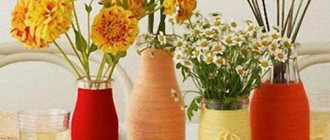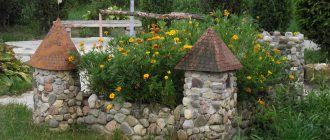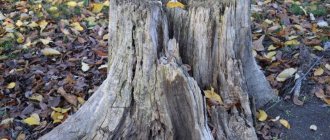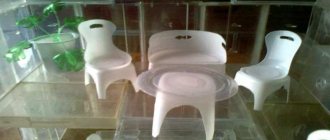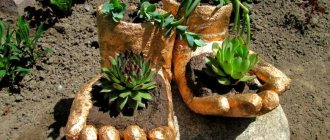Types and advantages of cement vases
The plasticity of the cement mortar and the high strength of the hardened material make it possible to create from it products of various shapes and sizes, from modest and simple pots for succulents to huge park flowerpots in the form of an open flower on a high leg and stand. And between them are pots, flowerpots and floor vases for indoor plants, garden flower beds, sculptural forms with recesses for planting flowers, solid fences in the form of a container without a bottom for installation directly on the ground.
But cement vases differ not only in size and appearance, but also in the quality of the solution, the presence or absence of reinforcement, and methods of manufacturing and decoration. There are a lot of them known, and designers often use them. But anyone who is not afraid to imagine and work with their hands can come up with their own version or improve the one they like.
Examples of simple outdoor flowerpots Source birchhilldam.com
Any plants - both indoor and garden - feel much better in a container made of concrete rather than plastic or metal. It does not heat up so much under the sun and retains moisture in the soil well. These flowerpots are especially convenient outdoors:
- they are durable, resistant to mechanical stress - shocks, scratches;
- concrete does not corrode and is not destroyed by humidity, frost, or sunlight;
- In each separate decorative container you can pour a soil mixture of the composition that is necessary for the plant grown in it;
- flowerpots, if they are not too bulky and heavy, are mobile and allow you to modify plant compositions on the site, transfer individual specimens to a warm place when cold weather sets in;
- they can be given exactly the shape that best fits into the landscape design.
This composition is suitable for a site in a rustic or eco-style Source kontakt-keramika.ru
The easiest way to make flowerpots with your own hands is from cement and fabric, and the most difficult to make are sculptured products, but this technique allows you to create the most interesting and unusual containers from antique amphorae to animal figurines.
A simple garden pot or raised bed made from old boards. With your own hands
Good day, friends! In this article I will share an interesting experience. It was always interesting to do something like this and so we decided to make several of these homemade products. It’s so exciting to try to do it yourself!?) Plus it’s useful! Agree? Let's go. If you are too lazy to read, you can always look here!
So dear friend. I live in a village and I don’t have a garden. Yes Yes. The plot is small, the soil is clay. And for garlic, I don’t think it’s advisable to spend time and effort on processing potatoes or anything else like that. But I love greens (onion, dill, parsley) and radishes. And it’s logical that I wanted it to grow all summer, and preferably not on clay. And also so that you can calmly approach it and not crawl on the ground.
Let's start with the fact that I already had a couple of these things, one multi-level. And one small one in one tier. Vases. I made these last year and it was nice to trim the onions and dill off them in the morning. But I wanted more radishes. And it was decided to make the flowerpot larger in area.
For this I chose old boards; they strengthened the formwork during the construction of the house. And they had already spent many years on the street, so it was definitely not a pity for them.
What you need for creativity
The set of materials and tools will differ depending on the chosen method of making a flowerpot.
Solution
The main ingredients for preparing the solution in all cases are grade 400 or 500 cement, sand and water. Their proportions vary depending on the consistency needed for the job. As a rule, they take 2 parts cement and 3 parts sand, and the density is set by adding more or less water.
For example, to pour into a mold, the solution should have the usual consistency of thick sour cream. For sculptural modeling, a more stable, non-flowing mixture will be required, and a vase made of cement and fabric on a bucket can only be achieved using a liquid solution that can completely saturate the fabric.
The consistency of the solution is selected in accordance with the manufacturing technology Source buy-brick-moscow.rf
The smaller the size of the pot, the more uniform the sand should be, so it is sifted to remove large inclusions. And vice versa: it is better to make large containers with thick walls from concrete with a large filler - gravel or crushed stone. Expanded clay is also suitable, which will also reduce the weight of the product and make it more mobile.
See also: Catalog of companies that specialize in the reconstruction and rebuilding of houses
Available materials
It is not at all necessary to have special tools and ready-made molds to make garden or indoor vases from cement. If you have empty plastic cylinders and canisters, old buckets and basins, unnecessary glass jars and bottles, they will all serve as molds for future products. In addition, unique shapes can be made from cardboard, plywood, foam plastic or scrap boards, creating original frames according to your own drawings and sketches.
Thick rubber gloves, worn-out shoes, bags, suitcases, balls, children's toys, old towels, bags, plastic boxes, baskets can also be used.
Decorative flowerpots from old things Source segodnya.ua
In addition, you will probably need the following auxiliary materials:
- polyethylene film;
- wire;
- plastic or metal mesh for reinforcing large products;
- short pieces of plastic pipes or wooden dowels for making drainage holes;
- oil or other lubricant for treating the mold before pouring concrete.
To prevent the solution from sticking to the mold, you can spray it with WD-40 Source userapi.com
Antique decor
Such a flowerpot can look very original; for this you will need to create an artificial aging effect reminiscent of the shabby chic style.
You will need:
- any flower pot;
- alcohol-containing liquid;
- sandpaper - grit 70 and 100;
- moisture-resistant putty;• acrylic paint.
Stages of work
- wipe the flower pot with an alcohol-containing liquid to clean it well, then sand the surface with sandpaper;
- cover with putty and let it dry;
- Apply paint on top (in the photo below it is pistachio color, but you can choose another), when it dries, sand it again with sandpaper.
Photo source: www.tutknow.ru
Methods for making cement flowerpots
Each of the technologies described below will allow you to create exclusive products, unique in shape and decor.
Method 1 - from fabric
Cement and fabric vases are the easiest to make. You need to prepare any container of a suitable size; it can even be full of holes, as it will only serve as a temporary basis for shaping. It is better to choose dense fabric, as it will become a reinforcing frame for the future flowerpot, ensuring its strength. This could be a terry towel, an old tablecloth or bedspread, burlap, or jeans.
- The fabric for fitting is placed on a container turned upside down.
- Folds are formed, excess is cut off, and holes for drainage are carefully cut out at the bottom of the flowerpot.
- Prepare a liquid solution from 1 part cement and 2 parts sifted sand.
- The fabric is soaked in the solution until completely and evenly soaked.
- Then they are again thrown onto the container covered with film and laid in folds.
Stages of making flowerpots from fabric Source waysi.ru
Wooden
The dacha is a place of maximum unity with nature, so everything natural here looks especially harmonious.
Benches, gazebos, and flowerpots made of wood fit confidently into the landscape of any site. From wooden slats you can make small flowerpots for annuals or spacious boxes for planting lush bushes and trees. The shape is usually chosen to be simple: rectangular, round or square. It is customary to leave the wood texture, covering it with a protective layer of impregnation and varnish.
Video description
How to make a vase from cement and waste fabric, watch the video:
Method 2 - from various containers
There are a great many options for making flowerpots using containers of different sizes. The algorithm is like this:
- select two containers so that one fits into the other, and between them there is free space of sufficient thickness for the walls of the pot;
- containers of larger volume are lubricated from the inside with any oil or special non-stick agents or covered with film;
- the smaller container is treated with lubricant from the outside;
- prepare a solution of normal consistency - not runny, but not too dense;
- a solution 3-6 cm thick is laid in an even layer at the bottom of a large container, depending on the load-carrying capacity of the flowerpot;
- insert a piece of tube of the same length wrapped in film or greased with oil into this layer in the center so that after its removal there remains a hole for water drainage;
- insert a smaller container inside, aligning it with the larger one so that the distance between the walls is the same;
- place a load in it to fix it in the desired position;
- the solution is poured between the walls, compacting and piercing with any suitable rod to remove air bubbles;
Manufacturing process and finished result Source kamburg.ru
Master class from a plastic barrel and wood
You can make a flowerpot from a plastic barrel. Simple containers can be used to create interesting flower arrangements. Plastic barrels for food use and some wood elements are suitable for this.
Inside these containers you can place a lemon tree, avocado or fig tree. Plants like this will make a wonderful backyard decor.
- To make it you will need a plastic barrel. It needs to be cut.
- The top can be cut off using a thin blade and saw. First, draw a cut line with a marker.
- Then the edges of the cut need to be processed to remove burrs. A special tool is used for this.
- Then you need to drill holes for drainage. There should be a lot of them. This will allow the liquid to drain from the container with the plants.
- Then you need to prepare boards of the same size.
- The boards should be run through a planer and cleaned a little. Then use a table saw to cut them into even pieces.
- Then the bars are attached to the barrel. The boards should be very close so that there are no gaps. The barrel must be completely covered with boards.
- It is also worth installing a wooden sheet at the bottom of the barrel.
- The planks can also be attached at a slight angle to each other. This will add originality to the product. The edge of one board is laid on top of the previous one.
- For better fastening of the boards on the reverse side, they can be fixed using a construction stapler.
- The boards are used to make a frame for the top of the barrel. For this, short sections of wood are used. They need to be cut at an angle of 22.5 degrees, which will make an octagon.
- Interesting decor can be made from small boards that are laid out side by side in a line. Glue is used for fastening.
- Additionally, two holes are made for pouring out liquid. You can use old fabric to cover the holes.
- Small pebbles are placed at the bottom of the barrels for drainage.
- The pots are filled with soil mixture. Most of it is compost. Then the plants are planted. Mulch is laid on top to protect the soil from drying out. To prevent wood rotting, it is recommended to treat the surface with varnish. This will increase the life of the product.
Video description
An example of making a flowerpot from a stocking and a tin can can be seen in the video:
Method 3 - sculptural
This method of making a flowerpot from cement is quite complex and requires artistic imagination and experience in sculpting and carving.
Experienced craftsmen use wet fine sand as the basis for creating the mold. It is poured into a suitable container, compacted thoroughly, and then the container is turned over onto a flat surface and removed. If you made sand cakes as a child, then you understand the technology. After the concrete has hardened, the sand can be easily removed from the flowerpot.
The resulting Easter cake is carefully doused with the solution and spread with a spatula over the entire surface. It is important to choose the correct thickness of the cement mixture. When this layer has set, prepare a thicker solution and begin decorating the walls. If you have no experience, you can start by simulating masonry, making lumps of different sizes from the mortar, gluing them to the walls and giving them shape. Then the excess mixture is selected between them, forming relief depressions - seams. When decorating, they are highlighted with color.
An example of a “stone” pots Source vkusnahka.ru
Clay
Clay is the ideal backdrop for almost any flower. The noble brown or beige shade of the flowerpot is in harmony with both greenery and multi-colored petals. The form, as a rule, is chosen to be simple. A highlight can be added using spectacular glazes during firing. Some will give the pot additional shine, others - dullness, and others - a cracking effect.
Containers of unusual shapes
To highlight the beauty of flowers, the shape for flowerpots is often chosen to be simple and concise. You can give free rein to your imagination by buying a pot for non-flowering plants (conifers or succulents). Originality can be added in several ways:
- Playing with geometric lines and planes.
- Using animalistic themes and the idea of physicality.
- Experimenting with sizes and proportions.
Homemade
Today, garden crafts made from old tires and worn-out shoes will surprise few people. When decorating a garden, summer residents are showing more and more creativity. An ordinary plastic bucket is often used as the basis for the vessel; shells, clothesline, woolen threads, dry branches, etc. are suitable for decoration. The skills of decoupage, hand painting, and sculpting will come in handy.
Using old interior items or wardrobe items to create designer flowerpots may also be appropriate, but completely “killed” items should be discarded.
Ethnic flavor
Flowerpots with national paintings and stucco will help create the atmosphere of a Japanese garden or a Russian estate. The basis is a plastic or ceramic pot, coated with acrylic primer and a layer of paint.
You can decorate the entire surface of the vase with painting or a three-dimensional ornament or highlight a small edging along the upper edge.
